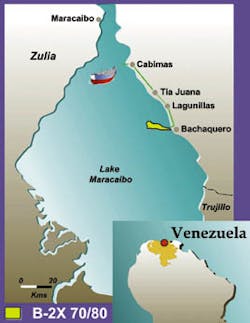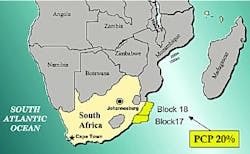PanCanadian seeking production hike from mature, deepwater plays
Jeremy Beckman
Editor, Europe
Map shows PanCanadian's acreage position in Lake Maracaibo block B-2X 70/80.
Operator applying leading edge technologies
Canada's most prolific driller is extending its reach to some of the world's emerging offshore hot spots. Over the past 18 months, Calgary-based PanCanadian Petroleum has participated in discoveries in the deepwater Gulf of Mexico, Australia's Carnarvon Basin, and the Timor Sea. In partnership with Phillips, the company is also assessing deepwater acreage in South Africa's Durban Basin and off western Scotland in preparation for imminent exploration wells.
According to Gerry Macey, Senior Vice President Exploration, PanCanadian has built up extensive drilling capability, deployed last year on around 1,800 wells in western Canada alone. Of late, it has built a track record in shallow gas and fast-track wells. "We've applied coiled tubing techniques to drill 800-meter sections in five and a half hours," says Macey. "We've also spudded two wells the same day using the same piece of equipment." In addition, PanCanadian has developed techniques applicable to long-haul, deepwater drilling, such as the EEx-led Llano discovery this June, which set a new depth record for a Gulf of Mexico well at 27,864 ft.
Offshore, PanCanadian's strategy is to promote some of its expertise (both proprietary and third party-accessed) as a way into promising exploration acreage or into mature producing fields in need of reactivation or redevelopment. In-house techniques that are being offered include downhole separation and high resolution sequence stratigraphy.
Mere Grande workovers
Despite its pre-eminence in Canada, the company is not too well-known overseas. This can make it difficult to enter a frontier offshore area, in particular as operator, according to Senior Vice President International, Paul Ellis. "We have to establish our credibility," he said. One offshore area where it did operate for a while was the shallow water B2X-70/80 block in Lake Maracaibo, secured in Venezuela's hotly contested 3rd Operating Agreement Round in 1997.PanCanadian had originally gone to Venezuela as a bidder in partnership with Marathon, but they lost out on their preferred target to Lasmo. Pennzoil too failed to secure the Mere Grande licence it had coveted, despite a three-year study on this field for PDVSA. Pennzoil ended up with B2X-68/79, adjacent to PanCanadian's block. "As they were already 50% partners in our block, and operating a similar-size block next door to ours, it seemed more efficient to transfer operatorship to them," Ellis comments, in terms of development and resource synergies.
B2X-70/80 covers 42 sq km of water 7-70 ft deep in Lake Maracaibo's northeastern sector. The field was discovered in 1950, with original reserves of 1,125 billion bbl of 20-25 degree gravity oil. Currently, 50 wells are active, with an estimated 76 million bbl remaining to be recovered. Some of the wells were in serious disrepair when the new partners arrived.
"We're limited by the existing infrastructure in terms of gas-lift systems," says Ellis. "Our first priority is to ascertain the condition of the multi-layered reservoirs - there's very little information available on where the production has come from. We need to get into the wellbores and find out where to put recompletions. It looks like we'll also have to apply different techniques in different parts of the reservoir." Ellis draws analogies in this productivity improvement exercise with PanCanadian's experience in the Samotlor project in western Siberia, where it was a partner with Canada's Fracmaster.
An integrated well services team will not be engaged in Lake Maracaibo until the partners get to grips with the scope of the work ahead - some of the wellbores are in quite good condition, Ellis adds. "Our first priority is data gathering, analyzing how the reservoir has produced for the last 40 years and how it will produce over the next 20." A newly commissioned drilling barge is due to commence workovers and drilling of new infill wells shortly. Reportedly, US$298 million will be invested in the project, with the aim of boosting production to 20,000 b/d by 2001. Current production amounts to around 3,5000 b/d.
In the UK, PanCanadian first gained a foothold in 1996 when it bought 50% of Oryx Energy's North Sea exploration acreage. Following several recent transactions, the company is now focused on the central North Sea plus three deepwater licences off western Britain. Phillips and Marathon operate two of these while Mobil leads the third, Tranche 61, where the first well is about to be drilled.
Like other North American independents, PanCanadian views the central North Sea as a low-cost, fast-track production opportunity via an array of small oilfields lying close to existing or emerging infrastructure. One of these is Milburn, discovered late 1996 in the Marathon-operated block 22/22c-3, in which PanCanadian holds a 10% interest.
South Africa's Durban Basin block 17/18, operated by Phillips, in which PanCanadian has a 20% share.Milburn, estimated to contain around 20 million bbl of oil in Tertiary sandstone, is situated 5 km south-east of Ranger's Selkirk discovery and 10 km west of Phillips' Kate and Shell's Tornado fields. The latter may be developed jointly, possibly through re-use of Phillips' Maureen platform, according to analysts Wood Mackenzie.
In other offshore arenas, PanCanadian holds 25% of Cultus' AC/P17 permit in the Timor Sea, which yielded the Tenacious oil and gas discovery from Tithonian sandstone in July 1997. It also has 40% of the Woolybutt discovery west of Barrow Island, off Australia's North West Shelf. Further appraisal is needed to delineate the field's extent, Ellis says - the partners are hoping for a reserve base of around 100 million bbl. PanCanadian has also secured stakes in three new permits in the Bonaparte Basin Londonderry High, in which Oryx is the operator. New 2D surveys, G&G
studies and a total of six wells are pledged for the three permits.
Last year, PanCanadian teamed up with operator Phillips to sign a four-year agreement covering 14.5 million acres in the Durban Basin off South Africa's southeast coast, between Durban and Richards Bay. Existing seismic indicated exploration prospects in the shallow and deep water areas. New seismic has revealed a particularly prospective target in 300 m water depth, which could be drilled shortly.
"Part of the appeal was that the acreage was so large," says Ellis. "If we can make a discovery, the chances of further discoveries on the same acreage will be high. Now we've also entered into a technical assessment agreement with Ranger Oil south of the Cape."
Finally, in the Gulf of Mexico, PanCanadian has built up stakes in 35 deepwater blocks (eight operated), and has participated over the past year in wells offshore Louisiana on Llano (two) plus the Sheba and Elvis prospects. Sheba's well had a similar TD to Llano's. In theory, according to Gerry Macey, oil production could start from Llano by the end of next year if agreement can be reached for a subsea tieback to the Cooper facility, five miles to the northeast.
Seismic studies
PanCanadian has access to numerous technologies which could benefit these projects. Its Geology Centre, for example, has developed a suite of integrated subsurface techniques, including high resolution sequence stratigraphy, to identify new play opportunities in areas previously thought to have been well explored.The Geophysics Centre has been working on a new approach for seismic interpretation which involves direct extraction of petrophysical attributes for improved detection of hydrocarbons and lithologic discrimination. The Lambda Rho/MuRho method applies a modified algorithm to seismic and log data that indicates compressibility and rigidity. This allows for a clearer identification of hydrocarbon-bearing formations, leading to:
- Improved petrophysical discrimination of rock properties
- Better drilling results due to improved interpretation of gas and light oil zones
- Lowered development costs.
"We're applying this extensively onshore Canada for finding gas resources. Internationally we're also using it for lithological identification. Once we've drilled a well, we can calibrate it." The technique is also being promoted as a means of entry for PanCanadian into promising offshore acreage - several operators off West Africa have already been courted concerning Lambda Rho.
Another technique refined by the Geophysics Centre is the MegaBin 3D seismic method, which according to PanCanadian "creates and samples wavefields in a very symmetric way, resulting in startling subsurface clarity. Surprisingly low cost is achieved by intentional coarse (or Mega) bin sampling, combined with appropriate interpolation during data processing". PanCanadian has used the method for three years on land is now moving it into marine environments. A US patent for MegaBin was received last July.
MegaBin employs parallel lines containing both sources and receivers as opposed to the traditional cross-line approach with sources in one direction and receivers in the other. According to PanCanadian, high-quality statistics have been generated in fold and azimuth distribution leading to a significantly cleaner, noise-free image compared to cross-line surveys. Initially, MegaBin has a coarser rectangular bin from acquisition, but the data quality allows a finer square bin to be achieved using interpolation and 3D migration, resulting in improved spatial resolution.
PanCanadian is also strong in subsurface separation of oil and water, gas and water, and sand. It helped develop the DHOWS (downhole oil/water separation) system as part of a
JIP with the Edmonton-based Centre for Engineering Research, and became the world's first oil company to test and use this technology for commercial production purposes. It has installed more than 10 systems to date. "The technology was developed primarily as a need because PanCanadian produces 800,000 b/d of water onshore Canada," says Ellis, "along with 130-140,000 b/d of oil. In a few years the water content will rise to 1 million b/d - that's a vast amount of fluid which has to be reinjected. It's becoming a very major exercise."
The DHOWS separator uses centrifugal force to split water and oil into two streams. Oil is pumped to the surface, while water is injected into an underground disposal formation. This reduces production of water to the surface by 90-95%, in turn lowering costs associated with corrosion, water disposal and energy consumption. Subsurface fluids separation also increases oil production and recoverable reserves through improved economics, based on lowered water handling costs.
PanCanadian is looking around for other producing fields elsewhere where it could transfer its solutions. "But there are specific requirements for reservoirs and fluids before you can apply these techniques. For downhole oil/water separation, you must have a reservoir horizon in which to inject or dispose of the water. You don't always find these in the right combination with oil-producing sections. But we're well ahead in designing and testing the necessary equipment.
"We have built a high volume system for use in 9 5/8-in. casing - we were looking at the possibilities of deploying this offshore, as it's too big for our current fields in Canada."
Copyright 1999 Oil & Gas Journal. All Rights Reserved.


